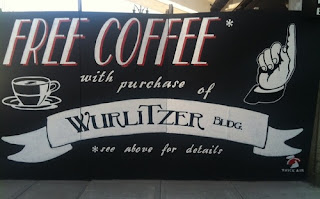Been meaning to blog about this private home at 26th and California in Santa Monica--but I'm rather a Johnny-come-lately (do people still use that phrase?)
I'm the latest in a long list of bloggers who've taken note. The house was mentioned in Mosaic Art Now, on the LA Is My Beat blog (from whence this first picture came), ExperiencingLA Blog (which posted pictures of the apple tree, below left), 365LosAngeles, and more--as well as a YouTube video (actually, several).
And the TV show Home and Garden has featured the house.
The house belongs to Louise and Aziz Farnam, who moved in when they immigrated from Iran in 1979. They raised six children here--but the house sat quietly, unnoticed and downright nondescript until 2002.
That's when Louise started creating the mosaics, after participating in a craft class at her son's school. Aziz jumped on the ceramic bandwagon very quickly so tiling the house with tiles they cut and placed themselves has been a joint effort.
Aziz estimates that 15 million pieces of tiles were used, starting with the apple tree, left. That apple tree--with not just red tile, but shaped, round, red tile apples--was the first picture they created, and more trees, fish, landscapes, abstracts, and religious figures followed.
And they kept going. Is there a 12-step program for mosaicists? Louise and Aziz have covered their house, garage, retaining walls, chimney, alcoves, patio, and pathways. They've added fountains and statues.
There are also mosaic portraits of Shamu the whale, a unicorn, an angel, exotic parrots (the family owns some live ones, but the mosaic images are larger than life). And that's just the outside.
Inside, according to the Travels with Two blog (which has a feature called "Weird Houses of LA") (I'm sure they mean that in the nicest way), there is a mirrored mosaic fireplace, mosaic pillars, and the furnishings are covered with chips and tiles and grout--the writing tables, coffee tables, lamps, benches, vases, trays, mirror frames, and picture frames.
Travels with Two also links to the Flickr stream, with even more pictures.
The back of the house, facing an alley, is a tribute to Hollywood, as well as mountains, rivers, and deco-ish doorway in greys, golds, and sand. Not a real doorway, though, just the image of one.
At this point, Ma and Pa Farnum have run out of wall space to play with (the kids have apparently battened down the hatches to their rooms) so the Farnams started a business, Custom Mosaic Art. This unicorn picture came from that website.






.jpg)







